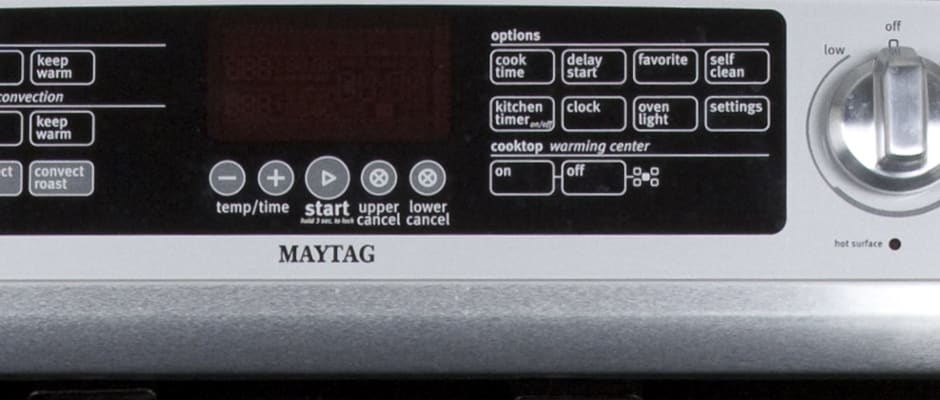Introduction
Is it a dealbreaker? Well, it depends. Consider your cooking habits as you read the strengths and weaknesses of this dual oven range's performance and features. This oven might be right for you, or it might not.
Design Overview
{{section_header}}{{section.name}}{{/section_header}}
The {{product.name}} is a freestanding, 30 inch range with stainless trim and two ovens. Its looks, unfortunately, better fit a range that costs a few hundred dollars less. Porcelain enamel is visible everywhere, and though it's got a substantial look and feel to it, there's no clean design language that's offered by other ranges selling for the same price. Although KitchenAid sits slightly higher in the Whirlpool brand hierarchy, just do some searching and you'll find KitchenAids with similar features to this Maytag selling for around the same price.
Front
{{section_header}}{{section.name}}{{/section_header}}
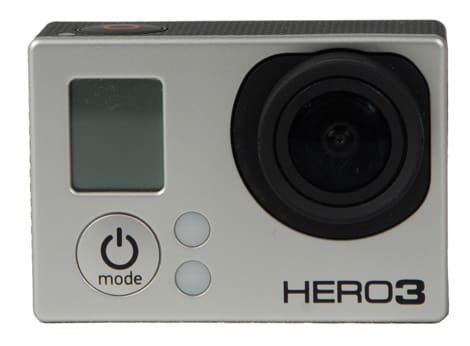
Range-top
{{section_header}}{{section.name}}{{/section_header}}
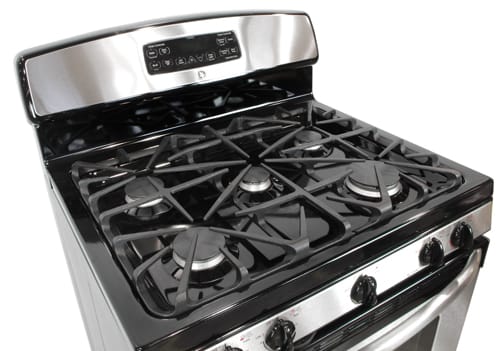
Upper Oven
{{section_header}}{{section.name}}{{/section_header}}
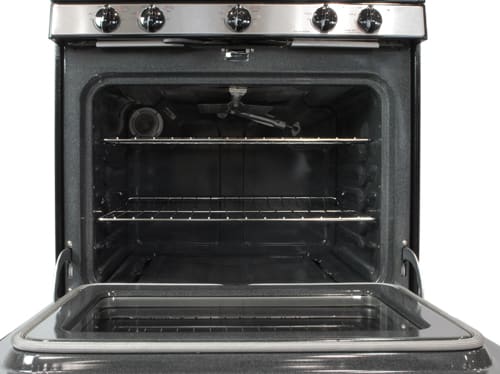
Lower Oven
{{section_header}}{{section.name}}{{/section_header}}


Broiler
{{section_header}}{{section.name}}{{/section_header}}
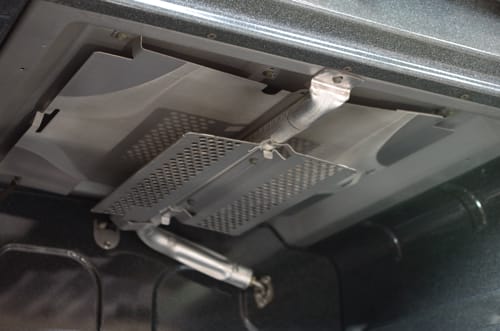
Cooking Performance
After running the {{product.name}} through the intense gauntlet that is our testing process, we've found some impressive results from this electric range. Aside for a few flaws, this oven's performance scored very well. Whether its boiling, simmering, searing, baking, roasting, or broiling, this oven proved to be a high performance machine.
{{photo_gallery "Primary Oven Keep-Warm Ramp-up", "Primary Oven 350F Ramp-up", "Primary Oven Max Ramp-up", "Secondary Oven Convection Ramp-up", "Oven Temperature Variance", "Range-top Water Boil", "Range-top Temperature Range"}}
Range Performance Overall
{{section_header}}{{section.name}}{{/section_header}}
The electric elements enclosed under the {{product.name}}'s ceramic rangetop exhibited their talents with decent boiling abilities, very high temperatures, and extremely low simmering temperatures. Being an electric rangetop, it's not as easy to zero in on the proper temperature there isn't any visual feedback of a flame after you adjust the knob.

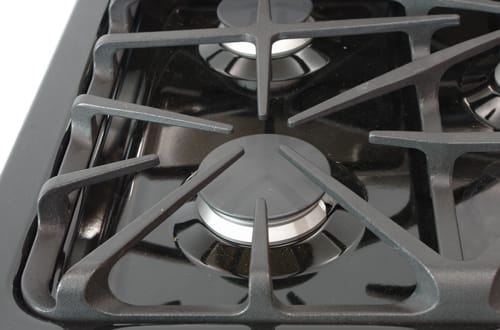
Water Boiling
{{section_header}}{{section.name}}{{/section_header}}
The {{product.name}} proved to be a satisfactory boiler, although its results didn't blow us away. The front right burner boiled the quickest, taking just under six minutes to boil six cups of water. The left elements boiled six cups of water in twelve and fifteen minutes. Remember, these numbers go down significantly if you boil your pot covered.
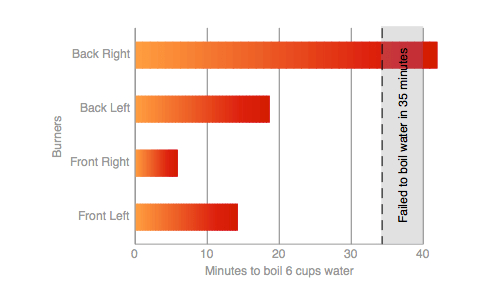
Don't try to boil with the back right simmer burner.
Low Temperature Cooking
{{section_header}}{{section.name}}{{/section_header}}
Better call this one the Hans Simmer, because the {{product.name}} impressed us most of all with an incredible flair for keeping the rangetop cool. The rear two burners could go as low as 91°F and 93°F, and the front right made it to 109°F. This is certainly low enough to keep even a small amount of liquid to a gentle simmer. We imagine you could also even melt chocolate without a double boiler, as temperatures this low shouldn't burn anything. Between gas and electric, it's always a trade off between temperature range and ease of adjustment. But on this rangetop, the range is even more pronounced than normal.
Range-top Temperature Range
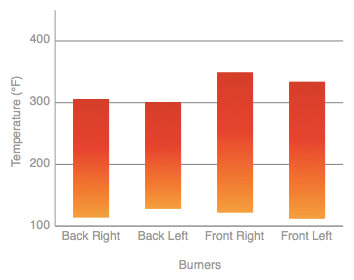
Maximum and minimum heat settings for each burner: The hottest burner reaches about 400F.
High Temperature Cooking
{{section_header}}{{section.name}}{{/section_header}}
Just as the {{product.name}} coolly simmered, it performed equally well at high temperatures--maybe too well. The two front power burners both heated up over 700°F, certainly hot enough to sear and char. We actually like to see temperatures a little cooler than this, as it's a fire hazard to run the burner that hot for anything more than warming up the burner or boiling. It might be wise to make sure that users know not to use those burners on high. The left rear burner also managed impressive temperature range, attaining the ideal temperature of 620°F.
Overall Oven Performance
{{section_header}}{{section.name}}{{/section_header}}
In five minutes, the {{product.name}} rocketed to 350°F, a very impressive 0-60 for an oven. Higher end temperature acceleration proved strong as well, hitting 500°F in eight minutes, proving this oven to be quite powerful. While the convection oven performed well, the conventional oven mode showed completely unacceptable variance. After heating up far past its target, it slowly cooled off until it was unacceptably below the target. Yes it might average out to be the target temperature, but at the cost of this huge variance, which may result in unsatisfactory cooking.
{{product.manufacturer_specs['Primary Oven Photo']}}{{photo_gallery "Primary Oven 350F Ramp-up", "Primary Oven Keep-Warm Ramp-up", "Primary Oven Max Ramp-up"}}
Target Temperature Accuracy
{{section_header}}{{section.name}}{{/section_header}}
The conventional top oven managed to hit temperatures up to 569°F, impressive, but unlikely you'd ever want anything but glazed pottery in there. On the lower end of the range, the {{product.model}} ran a bit hotter than what we like to see on the keep-warm setting, as it rocketed almost to 240°F and cooled off continuously until we stopped the test after twenty minutes.
Temperature Fluctuation
{{section_header}}{{section.name}}{{/section_header}}
The conventional upper cavity of the {{product.name}} had some trouble regulating its temperature, running hotter than it should have. After the very short preheat to 350°F, the oven kept going up to 400°F, past the acceptable upper bound of temperature. From there, until the end of our test, the oven kept cooling off from this maximum to a temperature far below the acceptable lower bound, ending up at 318°F at the time we concluded the test. Typically we see the oven's temperature flip-flop over and under the target. We only saw one arc of overshooting and undershooting.
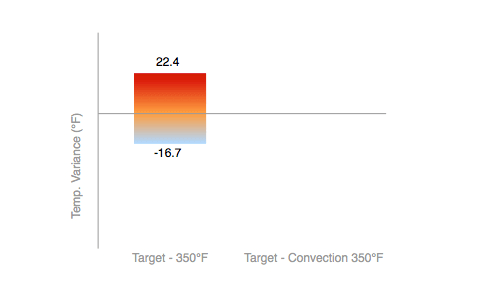
Oven "Margin of Error" in Temperature Variance: The oven is consistent at cool and mid-level temperatures, but inconsistent when operating at its warmest.
Secondary Oven Performance
{{section_header}}{{section.name}}{{/section_header}}
Despite the mediocre results of the conventional oven, the convection oven managed to sustain a temperature within a tight range of ±18°F off of 350°F. With the lower oven's heated convection fan cycling the hot air around the oven, this cavity should deliver the results we'd have liked to have seen in the upper cavity.
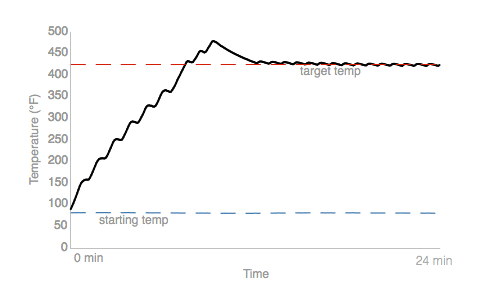
This is the upper divided cavity. After overshooting 425°F, it is ridiculously even.
Broiler Performance
{{section_header}}{{section.name}}{{/section_header}}
The broiler reached its target temperature of 600°F in twelve minutes. However, preheating is only necessary for five minutes in the upper oven cavity according to the manual. The manual has a broiling chart indicating at what setting and for how much time food is to be broiled.

Broiler Features
{{section_header}}{{section.name}}{{/section_header}}
The lower cavity has the ability to convection broil, which broils with the addition of the convection fan. Both broilers can be set to broil at "HI" or "LO." This lower temperature option is convenient when using thicker cuts of meat, as the outside won't get overcooked before the inside has chance to get cooked at all.
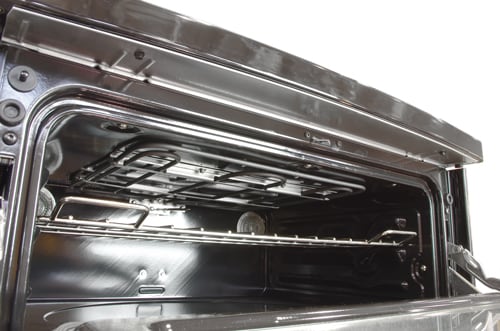
Overall Efficiency
{{section_header}}{{section.name}}{{/section_header}}
It's hard to calculate the efficiency directly, but we can determine how good the performance is for the energy spent going into it.
Range Efficiency
{{section_header}}{{section.name}}{{/section_header}}
The front left element drew 1792 watts on its normal setting, but it drew 2574 when used as a bridge burner. The high performance boiling burner in the front right position drew 3174 watts against the stated 3200. The rear left burner overshot the 1200 watts it was supposed to draw, guzzling 1799 watts. That doesn't speak too well for the rangetop's precision. The top right simmer burner and the center keep-warm burner hit their marks, drawing 714 and 100 watts respectively.
Oven Efficiency
{{section_header}}{{section.name}}{{/section_header}}
For the 4010 watts it draws, the {{product.name}}'s upper oven showed us very fast preheats, indicating that the oven doesn't waste the power it draws. As Energy Star doesn't certify ovens, the only way to really find the efficiency is to compare performance against energy draw. The lower cavity's element drew 3700 watts, and the convection element drew 3654 watts. Considering these numbers to the performance seems to indicate that the power is going to good use in the oven.
Features
{{section_header}}{{section.name}}{{/section_header}}
{{product.brand.name}} has updated the traditional four burner set up. The right rear simmer burner is gentle enough to keep things cool but hot enough at the same time, and if that's too hot, the 100W keep-warm burner can keep things even cooler. To the front of the rangetop, a ten inch "Speed Heat" element allows for the use of large stoveware and more surface area for better heat transfer. For even larger stoveware, the rangetop has a bridgeburner connecting the front and rear left elements.

The oven's most impressive feature may be its "Power Preheat," rendering the preheat to 350°F to an almost obsolete five minutes--and it's in both oven cavities. Saving the oven from our disapproval, the lower oven's convection feature enabled it to regulate temperature well and provided many different hybrid options of convection roasting, broiling, and baking.
Of course the main feature is the fact that the {{product.name}} has three racks over two ovens for a combined total of 6.7 cubic feet: 2.5 up top, and 4.2 below.
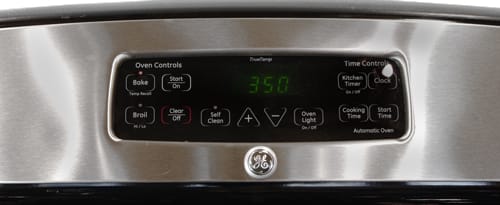
The timer is controlled with plus and minus keys.
{{product.manufacturer_specs['Timer Photo']}}
Controls
{{section_header}}{{section.name}}{{/section_header}}
The range controls on the {{product.name}} are, unfortunately, located on the back panel, behind where the pots and pans sit. If you're not very tall or use a wheelchair, this is an unacceptable setup.
Otherwise, the knobs themselves turn quite easily and offer as precise control as an electric oven offers.
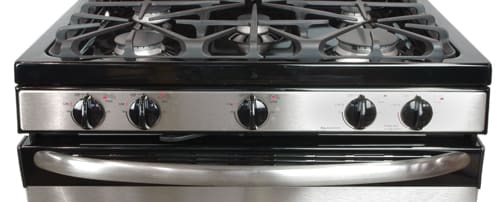
Oven controls are on a touch panel, and require a little bit of thought before use. That's partially due to the dual ovens, which each require their own sets of keys. Each has a bake and broil function, and the bottom oven features convection controls.

The broiler has the option of either low or high.
{{product.manufacturer_specs['Broiler Controls Photo']}}
Cleaning
Conclusion
{{product.vanity}}
For around $1,200 (MSRP $1,599), the {{product.name}} offers quite a lot--oven space, rangetop elements, and features. Although not without flaws, this oven may be a good choice, depending on the user.
The rangetop showed excellent temperature range, with excellent simmering and searing abilities. The various extra features such as the bridge element, the keep warm zone, and the "Speed Heat" boiling element make this rangetop attractive. The only downside the range has besides overheating slightly was the middling boiling scores. While the lack of blue flame makes it difficult to adjust temperature as precisely as a gas rangetop, these electric elements demonstrate the electric advantage with its wide temperature range.
In the caverns below, we found a similarly mixed bag tilted towards the good. We were thoroughly impressed by the spectacular preheat time, but at the same time the found the oven lacked adequate temperature control when used as a conventional oven. Especially, considering that only the bottom oven has convection--which controlled temperature quite well--this might be a single oven range in practice. While some food can handle the intense fluctuation, anyone requiring two ovens--serious bakers for instance--will most likely prefer a single high-performance oven instead. Oven-wise, this may be quantity rather than quality.
Despite its shortcomings, this oven might be a good value, as it is indeed a decent two oven range for well under $1,500. But before buying, we do recommend thoroughly make sure this is the oven for you by closely comparing this review to your needs.
Meet the tester
Ethan writes reviews and articles about science for Reviewed.com, and edits the Science Blog. He's originally from Vermont and thinks the bicycle and guitar are examples of perfected technology. Prior to Reviewed.com, he studied furiously at Middlebury College.
Checking our work.
Our team is here for one purpose: to help you buy the best stuff and love what you own. Our writers, editors, and lab technicians obsess over the products we cover to make sure you're confident and satisfied. Have a different opinion about something we recommend? Email us and we'll compare notes.
Shoot us an email
